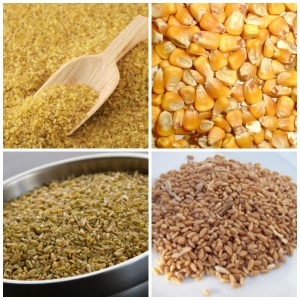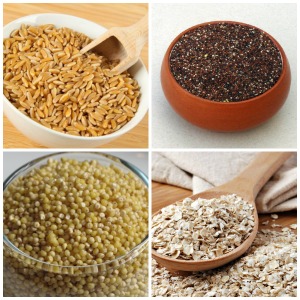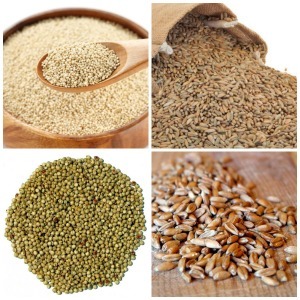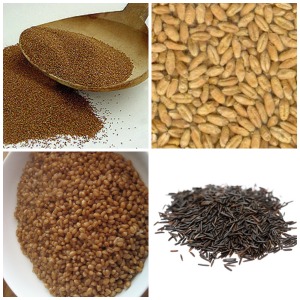This time at HNBT, we are going all grains, focusing on whole grains and their benefits. Whole grains are typically known as superfoods (foods with exceptional health benefits). But just before moving on to their benefits, allow us to first explain to you some basic facts and info that you should learn about them. Also, we have included an infographic to cut things short for better understanding at the end of the article.
What are Grains?
So what are grains? They are actually seeds produced by “grain crops”. These seeds are typically small, hard and dry with or without attached hulls or any fruit layers. They are consumed by both humans and animals.
Types of Grains
1. According to their cultivation, there are mainly two types of Grains; Cereals and Legumes.
Cereals: It’s grass, which are cultivated for its fruits called grains. Its fruits are composed of the endosperm, germ, and bran. They are also called staple foods because of their consumption and daily basic needs.
Example: Maize (corn), Pearl Millet, Proso Millet, Sorghum, Barley, Oats, Rice, Rye, Teff, Triticale, Wheat, Wild Rice, Finger Millet, Fonio, Foxtail Millet, Kodo Millet, Japanese Millet, Job’s Tears etc.
Pseudo-cereal Grains : These are plants and closely related to cereals. Cereals are pure grass but pseudocereals are not.
Example: Amaranth, Breadnut, Buckwheat, Chia, Cockscomb, Pitseed Goosefoot, Kañiwa, Quinoa, Wattleseed etc.
Legumes: A legume is a plant grown mainly for the fruit or seed. They are mainly grown for livestock forage and silage in Western countries. In Eastern countries they act as staple foods, such as cereals.
Example: Alfalfa, Clover, Peas, Beans, Lentils, Lupins, Mesquite, Carob, Soybeans, Peanuts, Tamarind etc.
2. According to modification process and consumption, there are two types of grains; whole grains and refined grains. It’s important that you learn the difference between these two types of grains. So here’s a further explanation on their difference :
Whole Grains : They contain the entire grain kernel (the bran, germ, and endosperm) and are very nutritious.
Example: Farro, Oat, Barley, Quinoa etc.
Refined Grains: Counterparts of whole grains i.e. refined grains have been processed in a mill to remove the bran and germ. Hence they lack in nutrition. This is because refining normally removes the bran and the germ, leaving only the endosperm.
Example: Rice, wheat
Another difference between them is that whole grains are always healthier than refined grains. Since they contain all three parts of the kernel, they have more proteins and nutrients. But after refining, about 25% of a grain’s protein is lost, along with at least seventeen key nutrients. Hence, it decreases the nutritional value. Processors will add back some vitamins and minerals to enrich refined grains, so refined products still give valuable nutrients. But whole grains are healthier, providing more protein, more fiber and many important vitamins and minerals.
Nutrients in Whole Grains and Benefits of Whole Grains
We all know that there are far too many benefits of eating whole grains. They are rich in fiber, which is useful to bring down blood cholesterol level and prevent constipation etc. Now coming back to the its benefits, here is whole grains list along with their nutrients and benefits.
A) Amaranth, Barley, Brown Rice and Buckwheat
1. Amaranth : It is a pseudo-grain.
Nutrients in Amaranth : Amaranth has a high level of the most complete protein; its protein has lysine, an amino acid missing or negligible in many grains. It is rich in iron, magnesium, phosphorus and manganese.
- Calories: 167
- Fiber: 3.0
- Protein: 6.10
- Gluten Free: Yes
Health Benefits of Amaranth :
- It has cholesterol-lowering properties and contains squalene, a compound that may help to prevent cancer.
- It has Anti-inflammatory properties and hence controls chronic health conditions such as diabetes, heart disease, and stroke.
- It has anti-hypertensive properties.
Also read : Foods To Increase Memory Power
2. Barley : FYI, it is a major cereal grain.
Nutrients in Barley : It is rich in fiber, manganese, niacin, and selenium.
- Calories: 159
- Fiber: 7.8
- Protein: 5.62
- Gluten Free: No
Health Benefits of Barley :
- The fiber in barley can help lower cholesterol. Its fiber content is more effective than oat fiber.
- According to British Journal of Nutrition, July 26, 2011:1-6, Barley is low-glycemic grain, meaning it doesn’t cause blood sugar spikes like other grains do.
- It also provides high concentrations of tocotrienols, a form of vitamin E which is helpful for cardiovascular protection and heart health.
Also read : Top 13 Superfoods To Maintain A Healthy Kidney
3. Brown Rice (Oryza Sativa) : It is rich is selenium, manganese and phosphorus.
Nutrients in Brown Rice :
- Calories: 166
- Fiber: 1.6
- Protein: 3.57
- Gluten Free: Yes
Health Benefits of Brown Rice :
- Rice is one of the most easily-digested grains. Rice cereal is often recommended as a baby’s first solid food.
- An extract from brown rice, called ethyl acetate, has been found to help protect the heart from diseases.
- According to a research work carried out at Madras Diabetes Research Foundation in India, brown rice reduces diabetes risk by decreasing a significant blood sugar level up to 23%.
- According to a study by International Journal of Preventive Medicine. 2014 Apr;5(4):478-88, brown rice has anti-inflammatory properties.
- Eating brown rice also has beneficial impact on cardiovascular diseases. It helps to lose weight, decrease waist and hip circumference, controls BMI, diastolic blood pressure and hs-CRP.
- It is rich in antioxidants like blueberries and blackberries.
Also read : 9 Iron Rich Foods To Combat Anemia
4. Buckwheat: Did you know, buckwheat isn’t a type of wheat at all – it’s actually a herb.
Nutrients in Buckwheat: It is rich in magnesium, copper and manganese
- Calories: 154
- Fiber: 4.5
- Protein: 5.96
- Gluten Free: Yes
Health Benefits of Buckwheat:
- It may help lower cholesterol level and cut hypertension, decrease blood pressure.
- According to Nutrition Research, June 2003; 23(6):803-14, buckwheat can act as a probiotic and helps to reduce weight.
- Buckwheat is the only grain known to have high levels of an antioxidant called rutin. Studies show that it improves circulation and prevents LDL cholesterol from blocking blood vessels.
Also read : 12 Reasons Why Peanut Is A Healthy Food
B) Bulgur, Corn, Farro and Freekeh
5. Bulgur : It is produced from wheat kernels. Wheat kernels are boiled, dried and cracked to get bulgur.
Nutrients in Bulgur : It is rich in magnesium and manganese.
- Calories: 154
- Fiber: 8.2
- Protein: 5.53
- Gluten Free: No
Health Benefits of Bulgur :
- It serves as a fast food which is high in nutrition. It has quick cooking time and mild flavor.
- Bulgur has more fiber per cup than quinoa, oats, millet, buckwheat and corn. These soluble fiber keeps food moving through your digestive tract and prevents constipation.
- It has no fat content which is very helpful for fat-free diet.
Also read : 8 Foods That Can Help You Grow Taller
6. Corn (Zea Mays May)
Nutrients in Corn : It is rich in magnesium, phosphorus, manganese, and selenium.
- Calories: 163
- Fiber: 3.3
- Protein: 3.65
- Gluten Free: Yes
Health Benefits of Corn :
- Corn has the highest level of antioxidants of any grain or vegetable!. It has almost twice the antioxidant activity of apples.
- It helps to prevent cardiovascular disease, diabetes, and cancer and other chronic diseases.
Also read : 9 Foods To Avoid During Pregnancy
7. Farro (Emmer)
Nutrients in Farro : It is rich in Zinc, magnesium and iron
- Calories: 170
- Fiber: 5
- Protein: 6
- Gluten Free: No
Health Benefits of Farro
- A cup of faro has about 8 grams of cholesterol-lowering fiber. That’s four times as much as white rice and double than brown rice
- Farro are full of minerals, including magnesium. It can relieve menstrual cramps and tension.
- The grain also has cyanogenic glucosides(carb), which can boost the immune system.
- It has complex carbohydrates which break down slowly. Hence it helps to keep your energy level stable.
Also read : Foods To Get Rid Of Flabby Arms
8. Freekeh(Roasted Green Wheat)
Nutrients in Freekeh : It is rich in carotenoids and lutein. Also rich in calcium, iron and zinc
- Calories: 150
- Fiber: 7
- Protein: 8
- Gluten Free: No
Health Benefits of Freekeh
- Freekeh has up to four times as much protein as brown rice, and it’s low on the glycemic index.
- It has low-fat content equal to brown rice.
- It is also good for colon health.
Also read : 6 Foods That Help Lower High Cholesterol
C) Kamut, Kañiwa, Millet and Oats
9. Kamut
Nutrients in Kamut : It has Zinc, thiamin, phosphorus, manganese, selenium and vitamin E.
- Calories: 152
- Fiber: 5.0
- Protein: 6.54
- Gluten Free: No
Health Benefits of Kamut
- According to a study, Scientists found that Kmaut is high in anti-oxidants.
- Kamut grain has higher levels of protein than common wheat.
- Zinc benefits your immune system and promotes healthy functioning of thyroid.
- Magnesium strengthens bone tissue and activates the enzymes your cells need to work.
Also read : How To Get Rid Of Stretch Marks?
10. Kañiwa : It is known as cousin of Quinoa
Nutrients in Kañiwa : High content of iron, calcium, and zinc.
- Calories: 178
- Fiber: 6
- Protein: 7
- Gluten Free: Yes
Health Benefits of Kañiwa :
- Research shows that kañiwa is high in the antioxidant quercetin.
- Kaniwa has even more protein, antioxidants, and iron than quinoa!
- Like quinoa, It has all nine essential amino acids which our body cannot produce.
Also read : How To Lose 20 Pounds In 2 Weeks?
11. Millet
Nutrients in Millet: Manganese
- Calories: 170
- Fiber: 3.8
- Protein: 4.96
- Gluten Free: Yes
Health Benefits of Millet
- Millet has shown to help control body weight and glucose levels
- It is naturally high in protein and antioxidants.
- Scientists at Sri Venkateswara University in India studied health benefits of Millets. They found that it may help to control blood sugar and cholesterol.
Also read : How To Get Rid Of Dark Armpits?
12. Oats
Nutrients in Oats : Rich in Manganese. it also has magnesium, phosphorus and thiamin.
- Calories: 2 (For rolled oats: 171)
- Fiber: 4.5
- Protein: 5.92
- Gluten Free: Yes
Health Benefits of Oats
- Scientific studies have concluded hat oats can be effective in lowering cholesterol.
- It may protect against coronary heart disease and colon cancer.
- It is also have a unique antioxidant, namely the avenanthramides, that helps protect blood vessels from the damaging effects of LDL cholesterol.
Also read : Easy Homemade Foot Soaks
D) Quinoa, Rye, Sorghum and Spelt
13. Quinoa
Nutrients in Quinoa: It has Folate, magnesium, phosphorus, and manganese.
- Calories: 166
- Fiber: 3.2
- Protein: 6.35
- Gluten Free: Yes
Health Benefits of Quinoa:
- Quinoa is one of the few grains or seed apart from Kañiwa that give the nine essential amino acids our bodies can’t produce on their own.
- The protein in quinoa is also complete protein.
- Quinoa offer anti-oxidants for gluten-free diet.
- According to British Journal of Nutrition, November 2005; 94 (5):850-8, It makes you feel fuller for longer time.
Also read : Health Benefits of Quinoa and Nutrition Facts [InfoGraphic]
14. Rye
Nutrients in Rye : Rich in Magnesium and have copper, manganese, selenium, , phosphorus.
- Calories: 152
- Fiber: 6.8
- Protein: 4.65
- Gluten Free: No
Health Benefits of Rye
- The type of fiber in rye promotes a rapid feeling of fullness. Hence, rye foods is a good choice for people to lose weight.
- It is also rich in antioxidants like wheat, corn, barley, sorghum, rye, oat and millet. All of them help to tackle chronic diseases.
- According to British Journal of Nutrition, November 2005; 94 (5):850-8, whole grain rye bread was most strongly associated with reduced mortality in men.
Also read : Natural Remedies For Skin Whitening
15. Sorghum / Milo
Nutrients in Sorghum : It has Magnesium, Phosphorus, Vitamin B6.
- Calories: 153
- Fiber: 3.8
- Protein: 5.09
- Gluten Free: Yes
Health Benefits of Sorghum
- Sorghum which is a gluten-free grain, is helpful for patients with celiac disease.
- It is rich anti-oxidants.
- It can decrease glucose response thus managing glucose and insulin levels.
- According to Journal of Agricultural & Food Chemistry. 2009 Mar 11;57(5):1797-804, sorghum have strong anti-proliferative activity against human colon cancer cells. That means it can inhibit cancer tumor growth.
Also read : How To Get Rid Of Body Acne?
16. Spelt
Nutrients in Spelt : Iron, phosphorus, manganese
- Calories: 152
- Fiber: 4.8
- Protein: 6.56
- Gluten Free: No
Health Benefits of Spelt :
- Spelt has double the protein that of modern wheat.
- It is easier to digest grain than modern wheat.
- According anecdotal reports that spelt is good for people sensitive to wheat. It is tolerable for them.
Also read : How To Get Rid Of Body Odor?
E) Teff, Triticale, Wild Rice and Wheat Berries
17. Teff
Nutrients in Teff : Iron, calcium, vitamin C, magnesium, phosphorus, copper, and manganese.
- Calories: 165
- Fiber: 3.6
- Protein: 5.98
- Gluten Free: Yes
Health Benefits of Teff :
- Another food for weight loss. Teff is made of high-resistant starch which help people stay fuller, longer.
- More starch value in teff can help prevent colon cancer.
- It has over twice the iron of other grains, and three times the calcium. That makes it an exceptionally important food for your diet.
Also read : How To Get Rid Of Bad Breathe?
18. Triticale
Nutrients in Triticale : Folate, Zinc, Copper, Manganese, Magnesium, Phosphorus
- Calories: 151
- Fiber: 6.6
- Protein: 5.87
- Gluten Free: No
Health Benefits of Triticale :
- High fiber content and manganese found in triticale is very helpful for people with diabetes.
- It is very powerful in terms of human digestion due to dietary fiber found in it. Dietary fiber helps to bulk up stool, pass food through the digestive tract quicker, and speed up the process of absorption and excretion.
Also read : How To Get Rid Of Dark Circles Under Eyes?
19. Wild Rice
Nutrients in Wild Rice : Iron, magnesium, phosphorus, copper and manganese
- Calories: 161
- Fiber: 2.8
- Protein: 6.63
- Gluten Free: yes
Health Benefits of Wild Rice :
- Another whole grain in list of gluten-free grains
- It has double the protein of brown rice. Hence, it has a lot of benefits.
- Wild rice also has the amino acid lysine, which promotes bone health and helps lower cholesterol (LDL Cholesterol).
- According to Nutrition Reviews. 2014 April;72(4):227-236 (Surendiran G et al.), Wild rice helps in prevention ofatherogenesis, a condition in which fat is build up in arteries.
Also read : How To Get Rid Of Wrinkles?
20. Wheat Berries : Eating wheat with whole kernels with only the hull removed.
Nutrients in Wheat Berries: Iron Selenium, Manganese, phosphorus, magnesium and folic acid
- Calories: 111
- Fiber: 4.3
- Protein: 3.5
- Gluten Free: No
Health Benefits of Wheat Berries
- It is full of anti-oxidants. Hence helps a lot as discussed above.
- According to a study by Journal of the National Cancer Institute, 2007 Mar 21;99(6): 475-86, Wheat berries containlignan, a phytochemical that may help protect against breast cancer.
- It makes you feel fuller than similar amount food made with wheat flour.
Also read : 19 Unbelievable Benefits Of Glycerin For Skin
Some people think that whole grains are bad for health. But it is not true. For evidence, we have already given you a huge list with all nutrients and health benefits of whole grains. According to our study of online reviews we found that quinoa tops the list of best whole grains. And we would like to know which one is your favorite from the list above. Don’t be shy, we welcome you to share your opinions here!
Hope you find our work useful. Anyway, here is a bonus infographic about whole grains which also covers on some simple recipes for whole grains.
![List of 15 Types Whole Grains and Their Benefits [Infographic]](http://healthnbodytips.com/wp-content/uploads/2014/07/List-of-15-Types-Whole-Grains-and-Their-Benefits-Infographic-e1412587302757.png)
Content sources: Wikipedia, Wholegrianscouncil, www.ncbi.nlm.nih.gov, Greatist.com,.
Image source: Internet, Greatist.com
*Nutrients according to FDA RACC — 45g.





